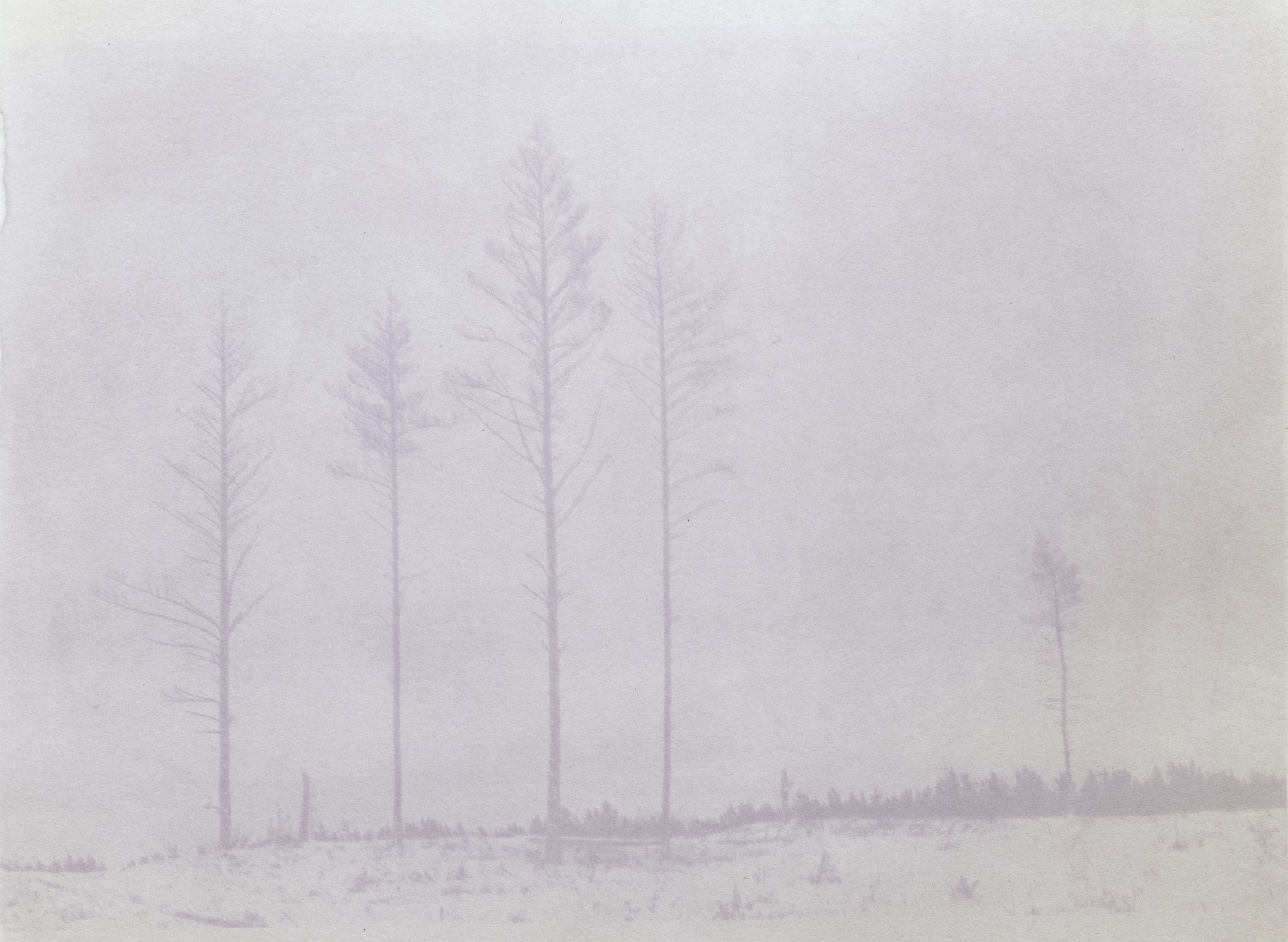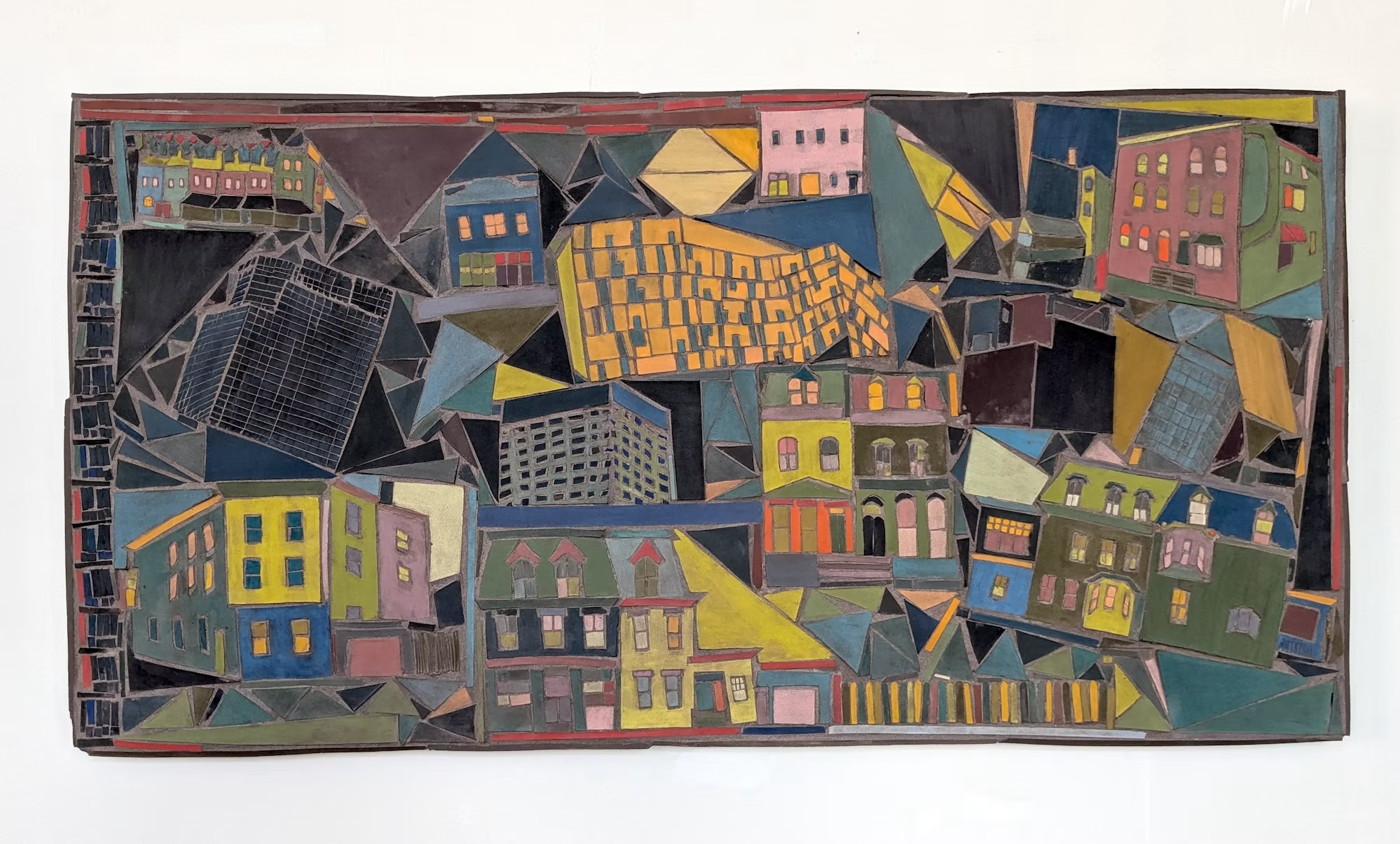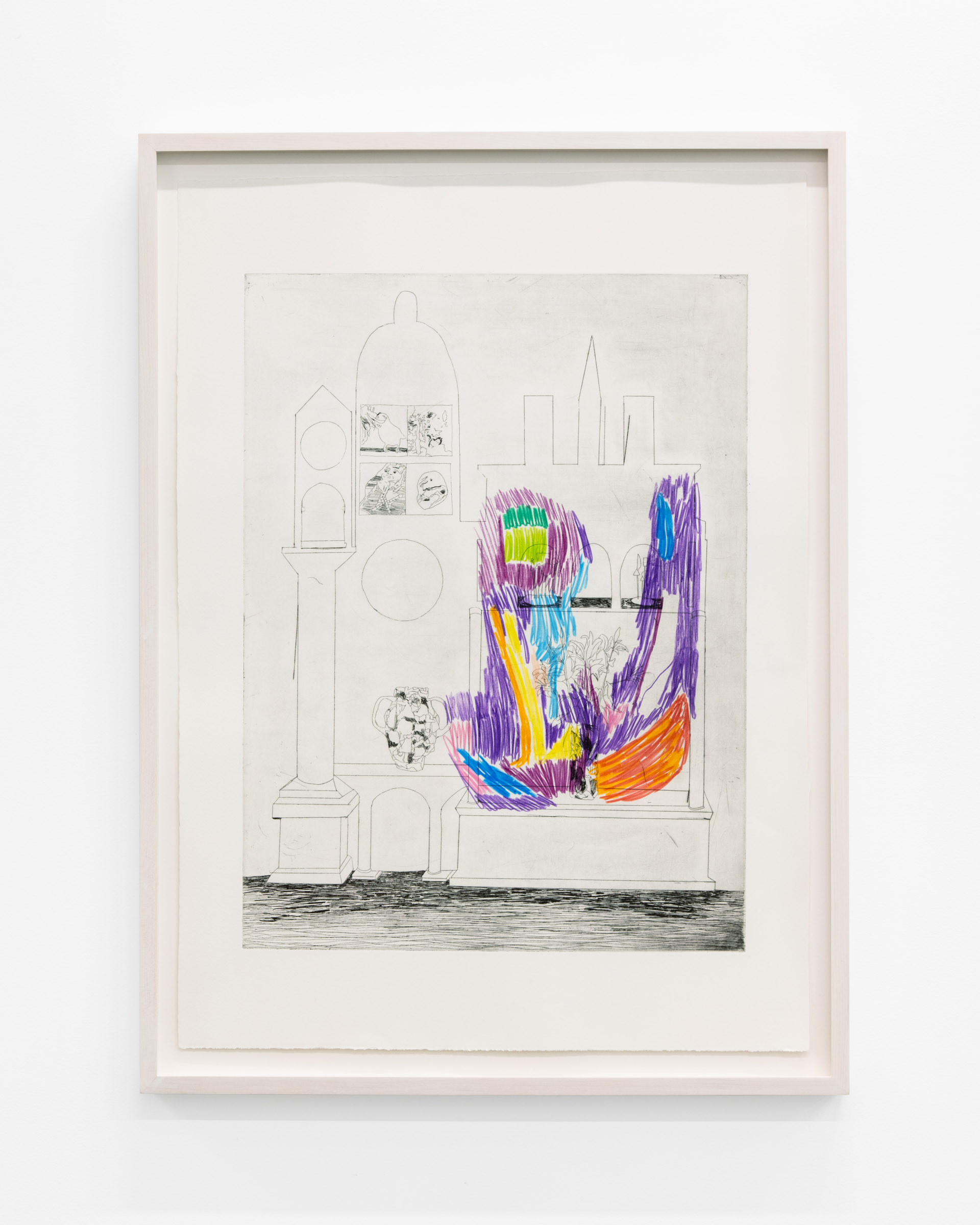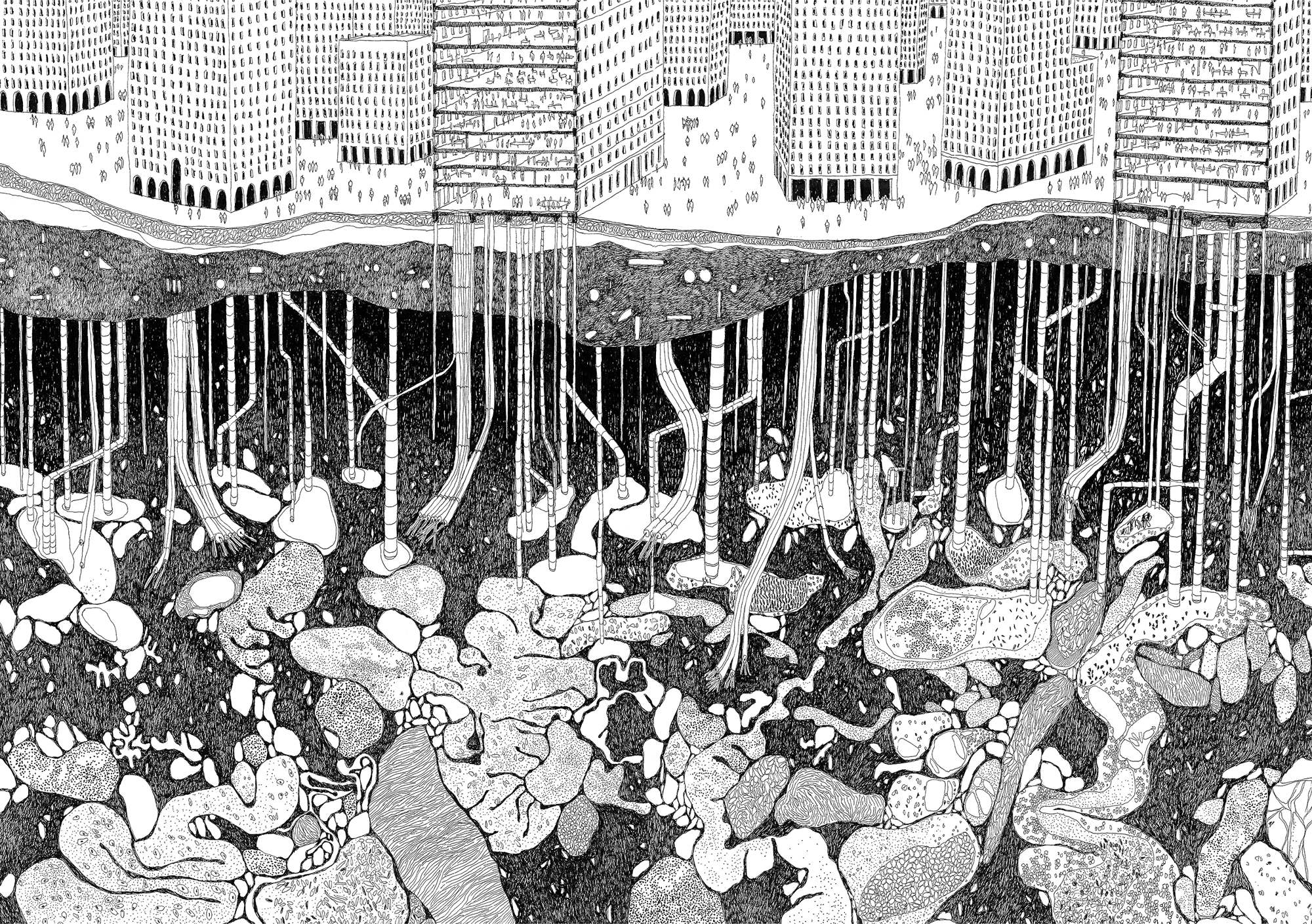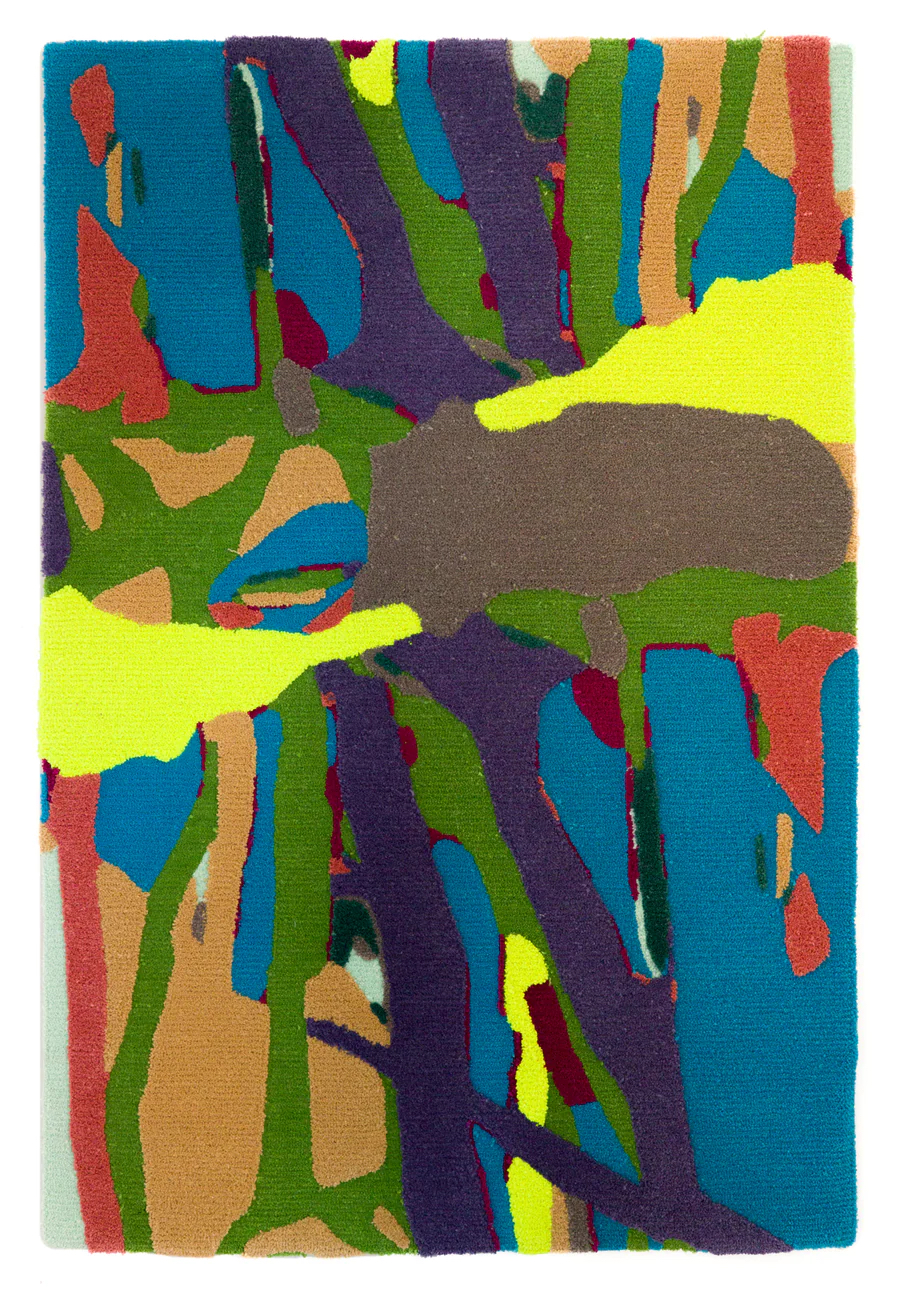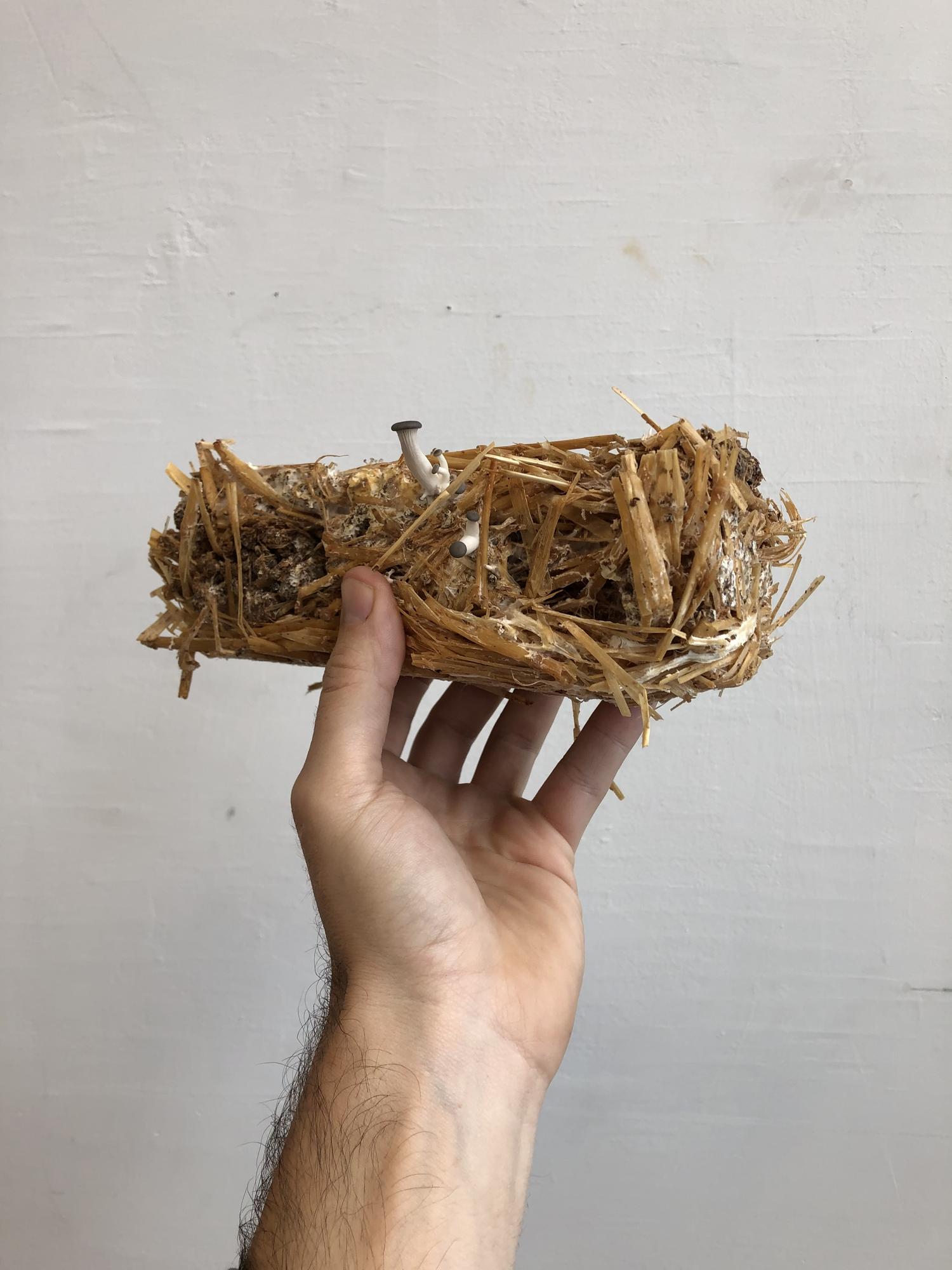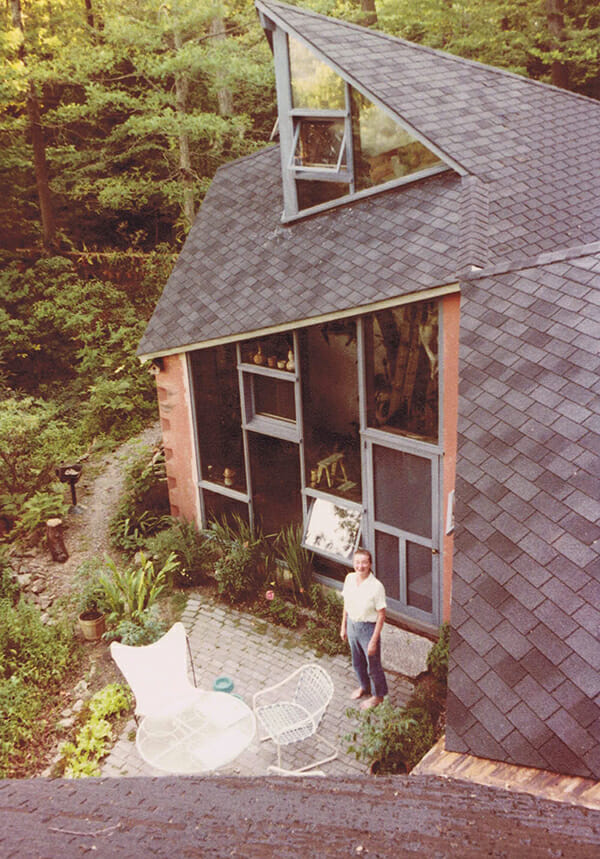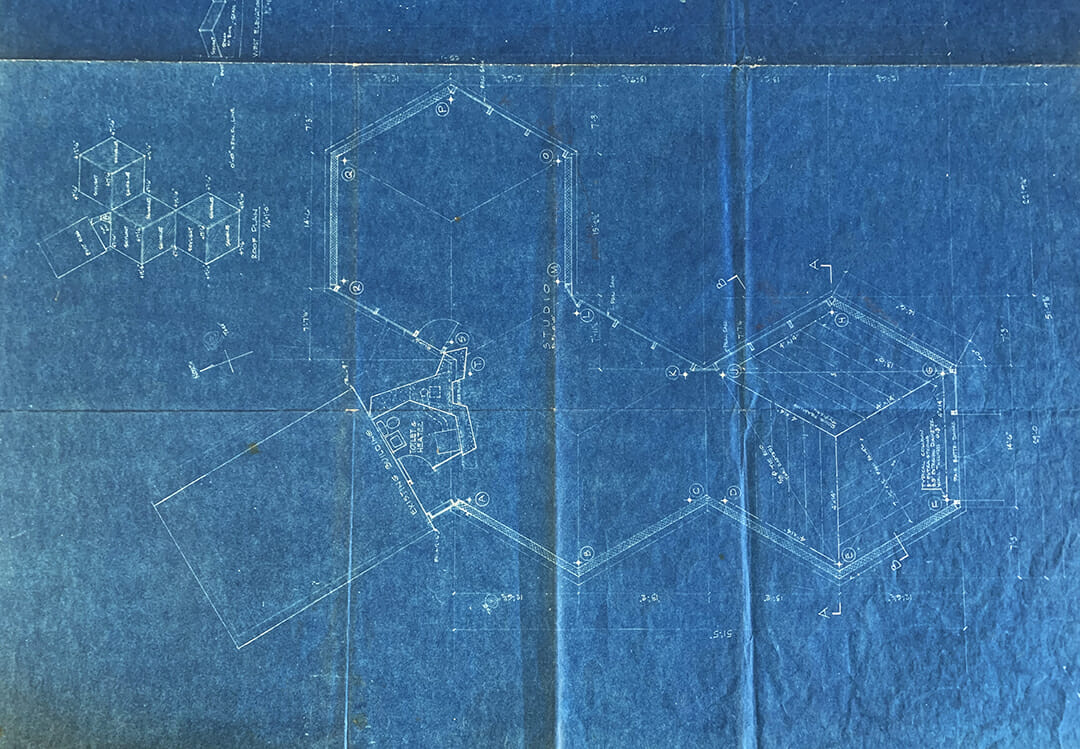The Bottling House exhibition program engages artists, designers, and future-thinkers whose work aligns with KieranTimberlake's mission to create meaningful, innovative, and environmentally-ethical architecture. This forum invites discussion and knowledge-sharing around ideas ranging from supply chain equity and environmental justice to embodied history and conservation of memory and materials.
The goal is not to propose solutions but create space for conversation.
The Bottling House is open by appointment only. Please contact gallery@kierantimberlake.com for scheduling.
Current and Upcoming Exhibitions
Partisan 4, haskap anthotype, 2025
Krista Svalbonas: Echoes and Remnants
Curated by Sarah Kaizar, Huwayda Fakhry, and TJ Hunt
September 4, 2025 - January 9, 2026
Opening reception: Thursday, September 4, 2025 from 5-8P. Free to attend, RSVP required.
The 20/20 Photo Festival is proud to present our 2025 featured exhibit with Philadelphia artist Krista Svalbonas. Responding to the theme of this year's festival Structures, Svalbonas will be presenting three interwoven series in a solo show titled “Echoes and Remnants” at the Bottling House Gallery at KieranTimberlake. The series explores Baltic resistance, displacement, and cultural survival. Rooted in personal history and ancestral memory, this work reflects on the impact of Soviet occupation across generations, landscapes, and architectures. Together, these series ask how landscapes, buildings, and material traditions carry memory, identity, and resistance. They honor those who fought, fled, and endured—and invite viewers to consider what survives in the aftermath of struggle.
From the artist:
My work explores ideas of home, dislocation, and the profound impact of architecture and landscape on cultural identity and human psychology. As the child of Latvian and Lithuanian parents who arrived in the United States as refugees after World War II, I have long been compelled by the tension between belonging and exile. My parents spent years in displaced-person camps in Germany—temporary, impersonal structures appropriated to house thousands of stateless people.
In my series “Displacement”, I conducted extensive archival research to locate, visit, and photograph many of these sites. Today, their ordinary facades conceal the tumultuous lives once held inside: the daily uncertainty, the plea letters begging foreign governments for food and protection, and the fear of forced repatriation. Through a process of laser cutting, I merge these archival letters with my photographs by burning the text into the images, an echo of the trauma that shaped these communities. Over time, the lace-like words consume the buildings, rendering them fragile and inseparable from the precarious lives they sheltered.
“What Remains” investigates buildings in Latvia, Lithuania, and Estonia that were built during Soviet occupation. During this period, cultural buildings were repurposed into warehouses, churches were demolished, and stark, cheaply constructed structures were built, along with a program of cultural suppression that left scars on the landscape that remain today. Despite this erasure, Baltic people preserved their cultural identity through folk traditions such as weaving. I combined my photographs of Soviet-era architecture with traditional Baltic textile patterns, laser-cut directly into the prints. The juxtaposition of cold concrete and delicate motifs highlights both the oppressive weight of totalitarianism and the quiet power of craft as defiance.
My most recent work, “Echoes of Resistance”, explores the forests that sheltered the Baltic Partisan movement—fighters who, in the aftermath of World War II, resisted Soviet occupation deep in the forest in secret underground bunkers, in hopes of reclaiming sovereignty and preserving national identity. Utilizing the 19th-century anthotype photographic technique—which employs natural plant pigments—I infuse each image with hues derived from the local flora, capturing the unique colors found in these locations. The process reflects nature's role as refuge and silent witness.
Across these bodies of work, I examine how landscapes and built environments hold memory—how they shape people and how people, in turn, resist, adapt, and leave traces of their struggle. My images become layered meditations on endurance, identity, and the quiet persistence of culture against forces that seek to erase it.
About Krista Svalboas
Krista Svalbonas holds a BFA in Photography and an MFA in Interdisciplinary Studies. Her work has been exhibited at prestigious venues, including Paris Photo, Utah Museum of Contemporary Art, Spartanburg Art Museum in South Carolina, Howard Yezerski Gallery in Boston, Klompching Gallery, and ISE Cultural Foundation in New York. Her pieces are included in private collections and public institutions such as LACMA in Los Angeles, the Cesis Art Museum in Latvia, the Gregg Museum of Art and Design in North Carolina, the Woodmere Art Museum, and Temple University in Philadelphia.
Svalbonas has received numerous awards, including the Penumbra Photogravure award (2025), the Center for Photographic Art Artist Grant (2022), the Baumanis Creative Projects Grant (2020), the Rhonda Wilson Award (2017), the Puffin Foundation Grant (2016), and a Bemis Fellowship (2015). Recently, she held solo exhibitions in Copenhagen, Denmark; Tallinn, Estonia; Augsburg, Germany; Vilnius, Lithuania; and Kedainiai, Lithuania. She is an associate professor of photography at St. Joseph's University and resides in Philadelphia, where she continues her work.
About the 20/20 Photo Festival
The 20/20 Photo Festival is a celebration of photography that brings together the Philadelphia photo community through city-wide exhibitions, educational programming, and a photo book fair. Originally organized in 2020 by representatives from Gravy Studio, The Halide Project, and Wanderlife Gallery, the festival has built a strong reputation from its inaugural year as a month-long virtual event to its current in-person manifestation. It brings together a wide range of perspectives from emerging and established photographers from Philadelphia and beyond, reflecting the diversity of contemporary photography, and foregrounds the goal of making art accessible and bringing it into the public sphere through free programming designed to inspire and educate. This includes exhibitions, workshops and demonstrations, artist talks, panel discussions, and a renowned photo book fair.
Past Exhibitions
Jennifer Johnson, Orange Sky, 2023, ceramic mosaics, standard 266, cone 6, velvet underglazes, wedi board. Photo credit: Neighboring States
Sidewalk Meditations from Powelton Village
Curated by TJ Hunt, Sarah Kaizar, and Huwayda Fakhry
May 29 - August 15, 2025
KieranTimberlake's Bottling House is pleased to present Sidewalk Meditations from Powelton Village, an exhibition featuring the ceramic works by Philadelphia-based sculptor Jennifer Johnson.
Jennifer Johnson's Sidewalk Meditations follows a decade of site-specific installations around Philadelphia, each shaped by extensive research into the physical and cultural history of a specific place over time. In 2022, the artist arrived at a question: Why not focus on where I live, the place I know best? Starting with her own house and block, Johnson embarked on a deep dive exploring and documenting her neighborhood, a process that has become a generative and ongoing place of discovery.
At its core, Johnson's work is about human experiences in a place over time, and how their meaning shifts. She's interested in how architecture reveals lived experiences, and the feeling of discontinuity that arises between a “before” and an “after”—often a nebulous zone. For Johnson, the life cycle of a building becomes a metaphor for aging and human lifetime; there's nostalgia and longing for something lost or forgotten.
While steeped in research and in-depth knowledge of her chosen place, the artist emphasizes the importance of working in a state of “not-knowing” and exploration—always concerned with the next question, trying for something unfamiliar that doesn't make sense at first. Clay, tile, and mortar—materials used to create brick and stone buildings—lend the work a self-reflexivity, while Johnson's rich use of color infuses her arrangements with emotion. Relying on an unsteady hand to cut, paint and assemble the work, the final product displays its flaws to highlight the human touch. It is, in the artist's words, a way of “knowing a place by hand.”
The exhibition's title references Descartes and his Meditations in several ways. Written in the 1600s, the essays are concerned with human knowledge and its grounding inside the human mind. While Johnson's work—"ironically,” notes the artist—is profoundly grounded in the physical world, her observations resonate: What can we know about a building that we only see from the outside? This boundary forms the perspective for the works on display: A view from the sidewalk leads to a residential façade, capturing the elements of separation between—maybe a fence and gate, stoop, or porch. The mosaics, like little stories or descriptions, are built up out of an accumulation of specific details—a series of meditations—to form intimate portraits of the neighborhood.
About Jennifer Johnson
Jennifer Johnson is a Philadelphia-based sculptor working in ceramics, fiber, electronics, video, and performance. Jennifer has been awarded artist residencies at Glenn Foerd on the Delaware (2019-2020), the Vermont Studio Center (2019), and the International Ceramic Research Center in Denmark (2017). From 2020-21, she served as a NewCourtland Fellow in partnership with the Center for Emerging Visual Arts (CFEVA). Her background includes a broad set of professional experiences. Jennifer is the co-founder of Current Designs, Inc., a high-tech company that produces computer response devices for neuroscientists. She also served as an editor for several journals including the American Economic Review, a fact-checker at the Philadelphia Museum of Art's publication department, and a cook at the Commissary Restaurant in Philadelphia and Grendel's Lair in Cambridge, Massachusetts. Jennifer holds an MFA from Tyler School of Art in Ceramics and a BA in Philosophy from Swarthmore College.
Jennifer Johnson, Big 7, 2024, ceramic mosaics, standard 266, cone 6, velvet underglazes, wedi board. Photo credit: Neighboring States
Cover: Building Ghosts: Past Lives and Lost Places in a Changing City, Published November 2024 by Temple University Press
Building Ghosts: Past Lives and Lost Places in a Changing City
Curated by Sarah Kaizar and Huwayda Fakhry
November 13, 2024 — May 9, 2025
“Building ghosts” are the idiosyncratic remnants or imprints of demolished buildings, left behind on the sides of neighboring structures. Mostly seen in older Northeastern cities with rowhomes or party-wall adjacencies, they can reveal remarkable things, such as an old staircase going up the side of a building or plaster traces left by a set of shelves in an attic gable. As history in our changing cities is erased and remade, these ghosts can be ephemeral or enduring. They can be quickly revealed and replaced in a neighborhood seeing rapid change or unveiled and never re-covered in a neighborhood that has not seen new construction in a long time.
Building Ghosts: Past Lives and Lost Places in a Changing City, authored by Molly Lester and Michael Bixler and published by Temple University Press in November 2024, features more than 100 striking contemporary color photographs and a deeply researched narrative about Philadelphia's buildings, neighborhoods, and the ghosts that reveal new truths and provocations about the changing city. The text and images in this lavish volume illuminate these lost buildings and found ghosts. Building Ghosts serves as an invitation to see the city differently, with the past clinging visibly to the present.
About the Exhibition
The companion Building Ghosts exhibition at KieranTimberlake interprets photography and essays from the publication with an installation incorporating 400 pounds of reclaimed material from Revolution Recovery, a construction and demolition waste recycling company in northeast Philadelphia. This single site processes more than 600 tons of building waste material per day. Access to the site was graciously made possible by RAIR, the artist in residence program whose mission is to challenge the perception of waste culture by providing a unique platform for artists at the intersection of art and industry.
About the Authors
Molly Lester is a historian of the built environment, and currently serves as the Associate Director of the Urban Heritage Project at the University of Pennsylvania's Weitzman School of Design. Her research interests include the ephemeral traces of "building ghosts" in the built environment and the role of women in shaping the American built environment in the 19th and early 20th centuries, with particular focus on architect Minerva Parker Nichols (1862-1949) and the She-She-She Camps of the New Deal. She is the author of Building Ghosts: Past Lives and Lost Places in a Changing City (Fall 2024, Temple University Press) and the co-author of Minerva Parker Nichols: The Search for a Forgotten Architect (2024, distributed by Yale University Press).
Michael Bixler is the Editorial Director and Chief Photographer of Hidden City Philadelphia. His writing and photography is focused on creating dialogue and documentation of the built environment and how it relates to history, culture, and the urban experience. Bixler is the photographer of Building Ghosts: Past Lives and Lost Places in a Changing City (Fall 2024, Temple University Press).
Robin Cameron, Memory Palace Castle (Cornell Print), 2019, Intaglio and Watercolor Monotype on paper, 30 x 22 in
The Roundness of Memory: Robin Cameron and Clément Masurier
Curated by Sarah Kaizar, Brigid O'Brien, and Huwayda Fakhry
March 8 — July 8, 2024
KT's Bottling House is pleased to present The Roundness of Memory, an exhibition featuring the works of Robin Cameron and Clement Masurier. Valuable yet impermanent, the methods of recording and recounting memory have evolved from storytelling to virtual reality. The path of recollection and realization is a matter of assemblage; a structural process of reviewing and editing one's relationship to history, reality, and potential. In this, memory is hardly real-time or collated, but rather distorted and of a round, quantum nature.
In conversation with Stephen Kieran's Living Memorials: An Invitation for All, the concepts of preservation vs. conservation are contemplated when the criteria is more than material. What are the opportunities and obligations to continue the comprehensible conversation that began before us and continues beyond? If 'lately' is the last millennia, what is now?
About Robin Cameron
Robin Cameron (b.1981, British Columbia, Canada) is an artist based in New York City who works in a wide range of media such as ceramics, brass sculptures, films, drawings, cyanotypes and printmaking. She often uses traditional media in an unconventional way to explore the boundaries of time, systems of thought, and identity. She is best known for making books which are available at Printed Matter and held in the collection of the MoMA library. Her work is in the permanent collection at the Whitney Museum. She graduated in 2012 with an MFA from Columbia University. She has worked as a visiting professor at Cornell University and Lehigh University and an adjunct at Rutgers University.
About Clément Masurier
Clément Masurier (b. 1990, Paris, France) is a licensed architect based in Paris who founded the firm Géométral in 2022. Its disciplinary foundation rests upon architecture, research, and education. In the manner of a small collection of architectures and programs, the projects undertaken by Géométral offer a unique universe each time. A multitude of different ambiences and atmospheres for the inhabitant, visitor, observer, or curious soul. From traversed landscapes, encounters with people, places seen and experienced, or stories recounted, the accumulated ideas have formed a material with which to work and share. Coupled with years of rich and diverse professional experiences, these imaginaries have given rise to realities and projects that extend their spheres of influence within the realms of architecture and space. Clément graduated in 2016 from the National School of Architecture in Paris Malaquais and in 2022 from the National School of Architecture in Versailles. He teaches at École Spéciale d'Architecture in Paris since 2020.
Clément Masurier, Chapitre Onze, 2015.
Tim Eads, JxDALL·E 2023 16.49.49 17302, 2023 (open edition, made to order), 100% New Zealand wool, tufted, 67 x 45 in.
Generally Electric: Carl Durkow, Tim Eads, & Benjamin Gillespie
Curated by Sarah Kaizar, Brigid O'Brien, and Huwayda Fakhry
October 13, 2023 — February 22, 2024
In celebration of DesignPhiladelphia 2023, KieranTimberlake is pleased to present GENERALLY ELECTRIC, a group exhibition featuring an eclectic and electric collection of work by Philadelphia-based artists, designers, and makers. On view is a selection of distinctive furniture and home accessories by Carl Durkow, AI-driven fiber work by Tim Eads of Tuft the World, and bespoke, Scandinavian-inspired lighting by Benjamin Gillespie of OVUUD.
About Carl Durkow
Carl Durkow is a Philadelphia-based furniture and object designer whose process involves taking the scenic route, sidestepping the digital realm and embracing the control of the human hand. With a dedication to physical experimentation and refinement, Durkow is interested in utilizing mundane details of the constructed world to foster surprise and intrigue. Inspired by the elegance of fine craft, surrealist painting, and historic furniture designs, he seeks to create objects meant to be lived with and cared for. While function is never neglected in the process, it often comes second to novelty of form and decorative reference. Durkow's creative journey is centered around evocative design, prioritizing sensory and tactile pleasures for anyone who encounters his work.
About Tim Eads & Tuft the World
Tuft the World was established in 2018 by Tiernan Alexander and Tim Eads, Texas-born artists and business owners living and working in West Philadelphia. The company was founded to provide tufters with the high-quality tools, materials, and instruction they need to make their own tufting projects. Tiernan and Tim's collective experience as crafters and educators, as well as their uniquely creative approach to art and life, inspire their mission to make the craft of tufting accessible to a broad audience, while staying true to their values of equity and sustainability.
About Benjamin Gillespie & OVUUD
OVUUD is owned and operated by Benjamin Gillespie, a Philadelphia based lighting and furniture designer. The stylistically pure aesthetic of OVUUD flows naturally from Benjamin's background in carpentry, metalworking, and engineering. This combination results in a diverse set of Scandinavian-inspired pieces that are individually distinctive yet cohesive as a collection. The primary focus of OVUUD is to utilize next-generation lighting technology to its fullest potential, thereby unlocking new approaches to how a lamp can look, feel, and function. Each piece is designed by hand in Benjamin's studio in Philadelphia and can be custom tailored to any unique set of criteria. Each piece is also fabricated from locally sourced materials - including Oak, Ash, and Walnut. Benjamin welcomes you to explore what OVUUD has to offer and see what makes the forward-thinking lighting and furniture design special.
Chris Riddle
Afterimage: Chris Riddle
Curated by Charlotte G. Chin Greene
July 20 — October 4, 2023
Offering new drawings alongside a series of oil paintings on drop-ceiling tiles that place abstraction and color field painting in equality with photorealistic reproduction, Afterimage extends motifs of pattern, depth, and representation through unmediated attention to surface. Gestural ink and charcoal echo the visual tactics of the ceiling tile paintings, grounded by a shifting horizon line that suggests a narrative thread. Void-like patterns and negative space iterate throughout, evoking window frames, clouds, or caves. A layered yellow and purple painting seems to evade visibility, both colors merging optically to produce what is colloquially known as “impossible color.” Framing new process-based works alongside earlier technical investigations, the works in Afterimage reckon with what endures in the act of discerning and demarcating boundaries, refusing or allowing appearance at the level of surface.
About Chris Riddle
Chris Riddle lives and works between New York and Philadelphia. Riddle completed an MFA in Painting from Tyler School of Art & Architecture in 2020. Also in 2020, Riddle was a Seasonal Fellow at Byrdcliffe Artist Colony, Woodstock, New York and curated 2020 Tyler MFA Painting at Massey Klein Gallery, New York, NY. From 2009-2017 Riddle assisted in the studios of Rudolf Stingel, Ellen Altfest, Kon Trubkovich, Jonathan Horowitz, and The Still House Group in New York City. From 2020-2021, Riddle worked with the artists Anoka Faruqee and David Driscoll in New Haven, CT. Most recently, Riddle has assisted in the studio of Dona Nelson. Solo presentations of Riddle's work include On The Line I and II, Byrdcliffe Artist Colony, Woodstock, NY; Hedge, Temple Contemporary, Tyler School of Art and Architecture, Philadelphia, PA; Fountains, Ugly Duck/Fuego, Rochester, NY; Self-Titled, Cameo Gallery, Brooklyn. Selected group exhibitions include A-I-R Exhibition, Byrdcliffe Artist Colony, Woodstock, NY; Everything Must Go, Atelier FAS, Philadelphia; Certain Ground, curated by Tausif Noor; 2020 Tyler Painting, Massey Klein Gallery, New York; National Arts Drive, Byrdcliffe Arts Colony, Woodstock, NY; America Now, Salt Studios, Brooklyn; Strip/Stripe, The Emily Harvey Foundation, New York.
Sean M. Starowitz
Charlotte G. Chin Greene, Wheel (Iris), 2021, High-impact acrylonitrile butadiene styrene, 24 x 24 x 3.5 inches. (Photo credit: Neighboring States Photography)
Remote Viewing: Charlotte G. Chin Greene
Curated by Sarah Kaizar and Charlotte G. Chin Greene
March 17 — May 5, 2022
Remote Viewing is an installation with CNC-fabricated, cast, found, and electronic objects that present the virtual as material. Image-making—from cave painting to satellite technology, from the pulse of an electron along a copper wire to the appearance of a digital image on an LCD screen—is a history of recursive modes of seeing mediated by tools. This is not to except non-human forms of biomimicry. Rather, it is to address a scale of vision, without eyes as we know them, which sees and shapes the world. I study how recursivity relates to the perception of space and time, and its effects in the realms of planetary-scale computation, cosmotechnics, global industry and labor.
Objects in this installation made from found and recycled high-impact ABS plastic, often used in car manufacturing, are connected in a remote viewing system. "Remote viewing" is a term for remotely accessing cameras on networked devices through the internet. It is also a pseudoscientific belief that a person can see or perceive objects located elsewhere. For a person experiencing dementia, the latter is not out of the realm of possibility.
This work is about witnessing my grandmother in her final stages of dementia, during the first year of COVID-19, primarily through video calls. A parallactic experience. Grief magnified through the starkness of Zoom and the vastness of the ongoing global pandemic, as well as racial and socioeconomic pandemics afflicting Philadelphia. Broken auto parts I saw while cycling (my sole method of transportation) came to signify a grief carried through not only my reality, but also the enormously complex circulation of material both viral and industrial. The act of picking up pieces of ABS plastic, manufactured in China, Taiwan and scattered along Diamond Street, Master Street, Aramingo Avenue, is simultaneously greater than, less than and equal to the sum of total actions that constitute this situation. To imagine such an act as the origin point of an iterative process of making limits my work to a linear scope, a human narrative, a single author, a final product. And anyways, an origin is just a coordinate reference that must be assigned.
I am gleaning—giving care to—remnants of memory, and imagining a circumstance by which they break from a repetitive loop and recurse, drawing a long gesture through their evolving forms, bearing witness to the motion in which we are altogether situated, and one day all together again.
In loving memory of 梅秀娴 (Sau Han Moy Yee) (March 19, 1927, Shanghai - January 28, 2021, New York City).
About Charlotte G. Chin Greene
Charlotte G. Chin Greene received their MFA in Sculpture from the Tyler School of Art & Architecture in 2021. Their research- and process-based practice studies time, machines, modes of sensing and perceiving, and the global flow of material. From new media sculpture to site-specific installations, Greene's work is achieved through utilizing digital fabrication tools and the practice of gleaning. Solo and two-person presentations of their work include Tack and Hide, Wick Gallery, Brooklyn; Red Work, Miranda Kuo Gallery, New York; Lamerica, Bible Gallery, New York; Anxiety Sex, Disclaimer Gallery, Brooklyn; in ATMworld, Chinatown Soup, New York. Their works have shown in group exhibitions including Ghost in the Ghost at Tiger Strikes Asteroid, New York and writing about their work can be found in Artforum, The Brooklyn Rail, and Bedford + Bowery. They are a 2021 Recipient of the Temple University Project Completion Grant.
Ruth Esherick outside studio designed by Louis Kahn. Wharton Esherick Museum Collection
Home as Site: The Wharton Esherick Museum & Louis Kahn
Curated by Emily Zilber
Director of Curatorial Affairs and Strategic Partnerships, Wharton Esherick Museum
December 3, 2021 — February 22, 2022
Finding that he needed additional space in order to keep up with demand for his furniture, Esherick's Workshop was built as an alternative to the small shop of his regular collaborator, cabinetmaker John Schmidt. While the nearby Studio and Garage had been constructed without formal plans, despite Esherick not being a trained architect, by the 1950s the requirement of a building permit necessitated that he find a licensed collaborator. Esherick turned to his renowned friend Louis I. Kahn (1901-1974), then a design critic and professor of architecture at Yale, where he had designed the university's art gallery among other buildings. While Esherick leaned towards organic forms, Kahn was known for his rigid geometry; the resulting workshop is a marriage of two highly idiosyncratic creative minds. Three hexagonal bays made from concrete blocks each housed one function of the Workshop. Where the walls join, there seem to be dovetail-like joints cut from each corner. While Kahn's drawings show straight walls, Esherick, who oversaw the construction, inserted a gentle curvature into the building's lines. Although both Esherick and Kahn's initials appear on the cornerstone, both men allowed the other to claim credit for the design. While the interior of the Workshop is not currently open to the public, long term plans include its transformation into public museum space exploring Esherick's material practice and influences. The exterior, however, is a part of the regular Museum tour.
Louis Kahn's Architectural Archives are housed in the Weitzman School of Design at the University of Pennsylvania. Kahn also designed a house for Wharton Esherick's niece Margaret, one of only nine private residences by the architect.
About the Wharton Esherick Museum
The Wharton Esherick Museum is the home and studio of famed American artist Wharton Esherick, located atop Valley Forge Mountain in Chester County, Pennsylvania. Set on 12 wooded acres, the Museum campus is comprised of multiple buildings including Wharton Esherick's Studio, which is now the centerpiece of the Museum. Esherick's highly individual, hand-built Studio was constructed over a 40-year period beginning in 1926, incorporating Arts and Crafts, Expressionist, and organic designs. Two years later Esherick began his 1928 Expressionist garage, now our Visitor Center. In 1973, just one year after its official opening as a museum, the Studio was added to the National Register of Historic Places. In 1993, the Museum was designated a National Historic Landmark for Architecture.
Esherick's 1956 Workshop, designed in collaboration with Louis Kahn, is also a part of our campus and a treasured piece of our landmark status. Additionally, Sunekrest, the 19th-century farmhouse where the Eshericks first lived on Valley Forge Mountain, was reacquired in 2014, the Museum is currently in the early stages of a campus planning process to explore how the farmhouse can be incorporated into the Museum experience.
The most recent addition to our campus is the Diamond Rock Schoolhouse. A Chester County landmark, this historic octagonal one-room schoolhouse located at the base of Diamond Rock Hill was an early painting studio for Esherick and is open to the public during select summer events.
The Wharton Esherick Museum is a proud member of the Historic Artists' Homes & Studios.
Louis Kahn, Workshop blueprint (detail), 1955, 29.75 x 36 in. Wharton Esherick Museum Collection



